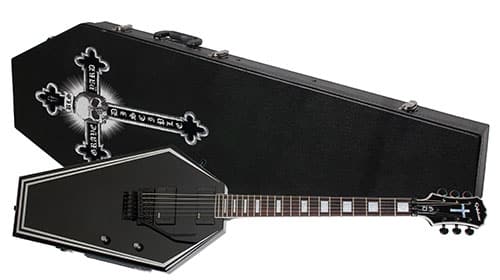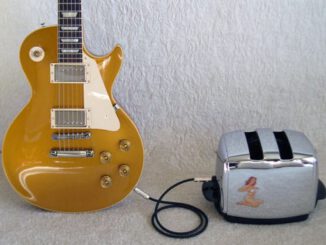There are dozens of direct-recording devices for electric guitars that offer surprisingly good-sounding facsimiles of miked guitar amps. But regardless of whether they’re tube driven, solid state or digital, these gadgets often lack the one crucial element that gives an electric guitar so much of its character: power tubes. While preamp tubes and transistors can generate a wide variety of pleasing distortion tones, they just can’t match the sensation of power tubes pushed to the point where the tube plates are shaking, the transformers are pumping and the amp is singing. It’s sensation you can feel from your fingers right down to the soles of your feet. Preamp distortion may be the sizzle, but power amp distortion may be the steak.
While many noteworthy attempts have been made at harnessing the sound of a raging amp to the point where you can play it in the same room as your grandma watching Jerry Springer reruns, the fact of the matter is, if you want it to sound and feel like a real amp, you’ve got to use a real amp. That’s what makes Lexicon’s Signature 284 so gratifying. First and foremost, the 284 is an all-tube, class A stereo amplifier with all the elements essential for true amplifier satisfaction. Designed by renowned custom amp builder Jon McIntyre, the 284 manages to squeeze two 3-watt amplifiers with EL84 power tubes, 12AX7 preamp tubes, heavy-duty transformers and a full array of tone and gain controls into a two-rack space. Add in a stereo effects loop, compensated recording outputs, uncompensated slave outputs and a pair of speaker outputs, and the 284 offers a full array of features that make it useful for almost any application you can think of.
Now of course everyone knows that speakers are a crucial part of amp tone, and leaving this out of the equation is like serving someone a double-cheese Fatburger without a bun—still pretty nasty, but it doesn’t quite cut it. While the signature 284 doesn’t have a built-in speaker, the speaker-simulation circuit in its compensated recording outputs provides bright switches that offer a choice of convincing 4×12 (disengaged) or 2×10 (engaged) settings that can be selected with the push of a button. If 4×12 or 2×10 tones don’t suit your fancy, you can always plug your favorite speakers into the 284’s speaker output (4 or 0 ohms) and mike them. Because the power ratting is only 3 watts RMS, you can get satisfying cranked-up sounds at a level that even your snoopy downstairs neighbor with Ross Perot-sized ears can tolerate.
The 284’s front panel is incredibly straightforward, and guitarists will have no problem dialing in their favorite tones in a matter of seconds. The gain control is just that, and by turning it up you increase the amp’s overdrive and distortion. For super-saturated, high-gain distortion, the knob can be out to engage a boost circuit. Unfortunately, Lexicon decided to use chicken-head knobs, and while they look cool, it can be difficult to get a grip sufficient to pull one of them out, especially after you’ve gobbled down a three-piece from KFC. There are also the standard bass, midrange, treble and presence controls, which, just like on a big tube amp, are interactive and provide a surprisingly wide variety of tones and colors. The left and right volume controls are where that magical power amp tone and power amp exists, and the more you turn them up, the more you can feel the growl and rumble in your fingertips.
Although the front panel is simple, the back panel has more jacks than a shifty Las Vegas card dealer. While there’s already a guitar input on the front panel, there’s also one on the back, which is welcome when connecting other rack-mounted devices to the 284’s inpuit or just using it with a patch bay. You can use only one input at a time—if cables are plugged into both inputs, the front jack overrides the back one. The 284 also features a stereo effects loop, which is great for use with effects such as compressors and reverb, which benefit from the added punch and warmth of being connected directly to an amp. The left return is mono and the right return is split, which provides a number of useful options, such as using separate effects on each channel or using the left channel dry and the right channel with processing.
The 284’s tone, gain and volume controls provide a surprising amount of tonal flexibility for a 3-watt class A amp. With the volume turned up almost all the way and the gain edged up a few notches, the 284 pumps out a full, harmonically rich clean tone with just a slight edge of overdrive. Engaging the boost switch, cranking up the gain and turning down the volume churns out a roaring distortion that would make even Dimebag grab for the Viagra. Whether you want smooth, clean jazz tones, loose, bluesy overdrive, crunchy grunge bark or doomsday death distortion, it’s all a few knob twists away.
The aforementioned recording outputs have XLR jacks for plugging the 284 directly into a mixing console as well as ground-lifting switches for eliminating the nasty buzz of an underground circuit. If your mixer doesn’t have XLR inputs, you can use XLR to ¼ -inch adaptors or employ the slave outputs, which have ¼ -inch jacks. However, the slave outputs don’t have the speaker simulation circuit, so you may want to run an equalizer between these inputs and your console to roll off some of that direct-signal bite. The slave outputs can also be connected to a power amp or even another guitar amp, giving you added control over the 284’s overall volume level. Connect the 284 to a power amp, and you can tweak it until it screams like it’s about to explode, and yet turn the overall volume down to a whisper. Or you can boost the 284’s output to a volume level that’s ideal for live performance.
The 284’s left and right speaker outputs feature 4/8-ohm switches, so you can use different types of speaker cabinets for each channel, if so desired. To prevent frying the transformers when speakers aren’t connected to the unit, the speaker outputs feature independent passive loads that are automatically engaged when cable is unplugged. (Just make sure you unplug the jack from the 284 first rather than from the speaker cab.)
All of these output options can be used in any combination you like, which provides incredible options for recording guitar tracks. For example, you can record a direct signal from the recording outputs, mike a single 12-inch speaker cab and a 2×10 cabinet at once, and connect the slave outputs to separate combo amps for further tone tweaking. But even if you just like the simple route and plug directly into your mixer from the recording outputs, the Signature 284 sounds incredibly rich, realistic and rewarding.





Be the first to comment